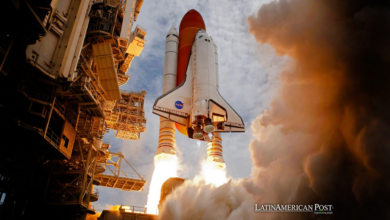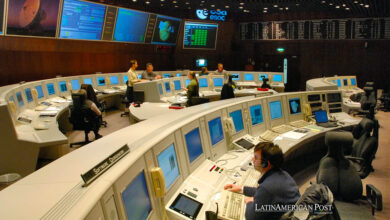The Space Race of Lunar Exploration is Also Private
The exploration and successful landing on the Moon had been carried out by the space agencies of the governments of the United States, China and the extinct Soviet Union. But now private companies could also venture into the conquest of the only natural satellite of our planet.

Photo: ispace-inc
LatinAmerican Post | Julián Andrés Pastrana Cuéllar
Escucha este artículo
Leer en español: La carrera espacial de la exploración lunar también es privada
The first moon landing of a private spacecraft was expected to take place on April 26. This ship, manufactured by the Japanese firm Ispace, which carries a Rashid rover from the United Arab Emirates inside, actually reached space. However, flight controllers on the ground were unable to regain contact with it as it approached the Moon, so the company believes the spacecraft was lost.
“We have to assume… that we were unable to complete the moon landing on the lunar surface. Our engineers are continuing to investigate the situation," Ispace CEO Takeshi Hakamada said. However, the company also ensures that there is a high probability that the lander has finally made a forced landing on the surface of the Moon. However, they consider the feat a success and a good start for lunar exploration by private parties, according to their official press release.
M1 took off from Cape Canaveral (Florida) aboard a SpaceX rocket in December 2022 and its final destination was expected to be the Atlas crater located in the so-called Cold Sea of the Moon, a territory that until now had not been explored. Throughout those months, the ship used the force of gravity of the Earth and the Sun to guide itself towards its destination. This gave rise to the fact that the M1 could carry a heavier load, since by not using a direct route it required less propulsion. The learning obtained by the company will be used in upcoming missions, which are scheduled for the next two years.
We suggest you read: A milestone in space history: NASA presented the four Artemis II astronauts
Once a successful landing is achieved, the ship will recharge its battery and then release the Rashid rover, as well as a Japanese-made two-wheeled robot, into lunar territory. Rashid, whose size is 50 centimeters and weighs 10 kilograms, will begin to travel a few hundred meters around, but without leaving the Atlas crater. During this tour, it will study particles in the lunar soil through a microscopic camera called regolith, as well as a thermal camera to analyze the geological properties of the terrain.
The analyses made by Rashid would serve as a starting point for studying the solar system, since, as explained by Mounib El-Eid, an astrophysicist at the American University of Beirut in an interview with Nature Magazine, a primitive record of that system can be found on the lunar surface. In addition, this celestial body lacks tectonic plates and has not been exposed to surface erosion.
Similarly, this Arab-made rover will analyze lunar dust characterized by its sharp edges like glass, which over the days can cause damage to astronauts' equipment and their space suits. It is key to discover how to prevent the effects of this lunar dust in order to establish permanent space stations on the moon in the future. In this regard, Rashid will experiment with different materials, including graphene-based compounds, adhering them to its wheels in order to check those that are most suitable for manufacturing the hardware used in future missions.
Along with the rovers, M1 will come equipped with a 360-degree camera made by Canadian company Canadensys. During the course of the missions, the performance of a solid-state battery manufactured by the Japanese company NGK Spark Plug will also be tested.
A long term project
More Ispace launches are planned for 2024 and 2025, a project whose ultimate goal is to collect water on the Moon, since it is estimated that this liquid could be used to make rocket fuel that allows exploring the solar system at lower costs. Abigail Calzada Díaz, a geologist and specialist in lunar exploration at the European Space Resources Innovation Center in Luxembourg, added in an interview with Nature that the success of these privately sponsored commercial missions will allow other firms to become interested in this type of project, which will undoubtedly result in benefits for space research.
Private lunar and space exploration
However, it is not the only private company interested in exploring the moon and, probably, profiting from said explorations and the generation of knowledge. In 2019, the Israel-based company SpaceIL unsuccessfully attempted to send a spacecraft to the moon. It must also be remembered that, although with other interests, in 2020, Elon Musk's SpaceX became the first private company to put people in orbit. So did Richard Branson's Virgin Galactic and Jeff Bezos' Blue Origin.
In this sense, private interests are changing the space race and lunar exploration and other celestial bodies. Areas such as space tourism, the search for resources and work with satellites are of interest to private parties. "Declining costs for launch and space hardware in general have attracted new entrants to this market, and companies in a variety of industries have already begun to take advantage of satellite technology and access to space to drive innovation and efficiencies. in their terrestrial products and services," points out the Harvard Business Review as a motivation for companies to join space exploration.



